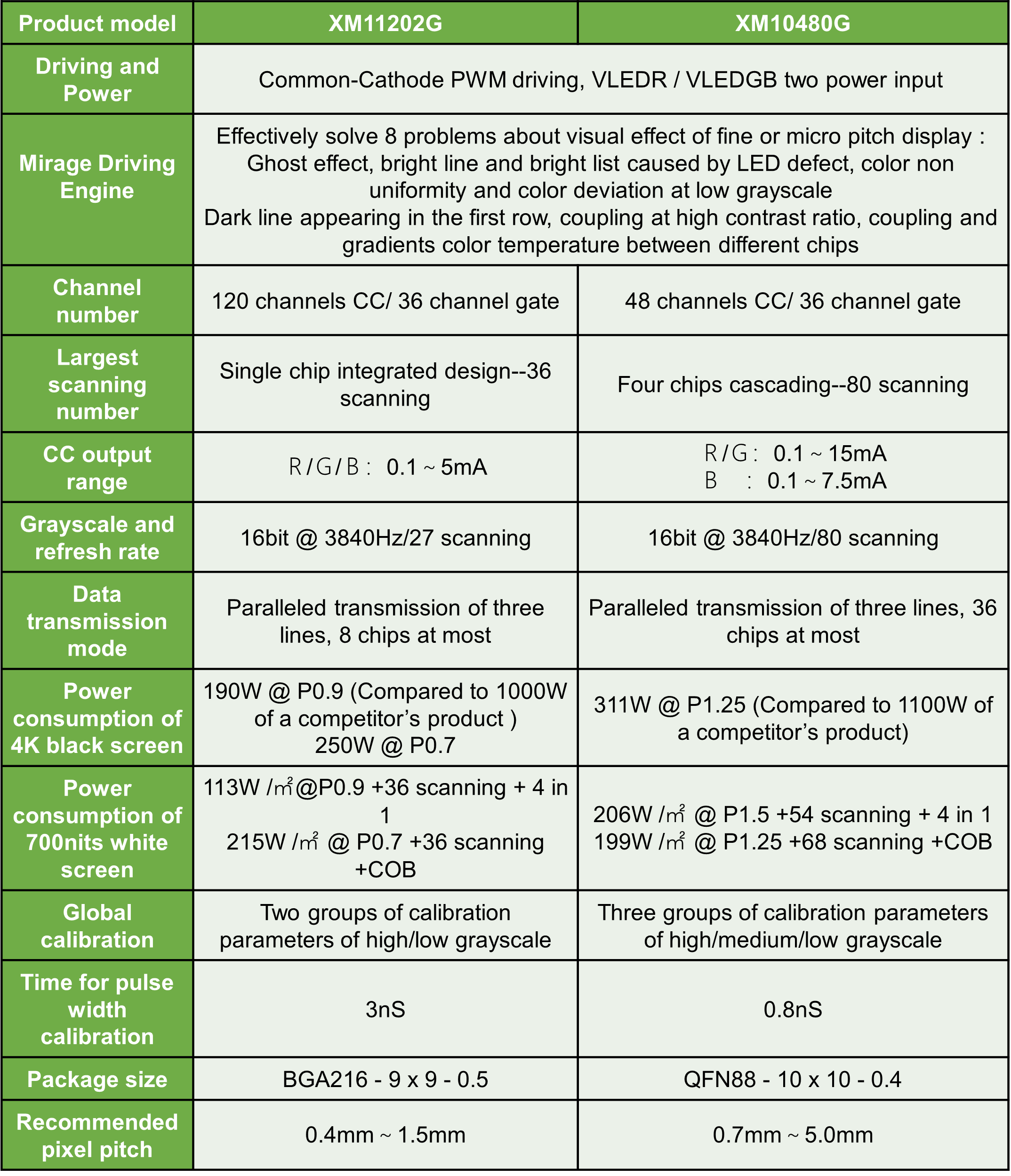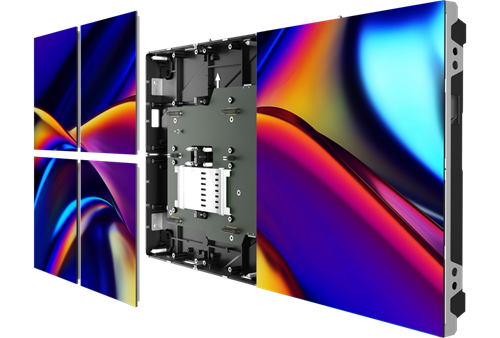As next-generation display technologies, Mini/Micro LED and fine pitch displays have been in the limelight for many years. Compared with traditional LED display, the most striking feature of next-generation display lies in its unparalleled visual effect, including high resolution, high contrast ratio, high brightness and wide color gamut, marking a revolution of display technology and an improvement of consumer demand.
The Design Complexity of Drive IC up a Notch
As scientific technology and life quality improve, new things such as smart wearable device, telecommuting, telemedicine, home theater, autostereoscopic 3D display, virtual live streaming room gradually become part of our daily life. In recent years, the diversification of end demands and the burgeoning growth of ultra-HD video, 5G, 8K and IoT technologies have not only created multitudes of development opportunities for Mini/Micro LED and fine pitch display industries, but also pushing technical level to an all-time high. In this context, high HDR, high refresh rate and high graylevel become the prominent characteristics of top-class LED display.
On a technical basis, the upgrading of display performance finds expression in smaller pixel pitch, exponentially more LEDs and more precise control, which indicates that the technical difficulty of the whole industry hits a new record. For instance, drive IC--a pivotal control device of display--faces higher complexity in design and techniques.
LED drive IC works to drive LED to emit light or enable LED module components to operate normally at the optimal voltage or current conditions. As LED pixel pitch gets smaller, drive IC will face four challenges. First of all, the power consumption of drive IC will have a higher proportion. In a P0.9 COB-based 4K display, for example, up to 72% of power consumption is generated by drive IC. Secondly, it is hard to realize perfect low graylevel effect under low current condition. Thirdly, it’s not easy to maintain high color depth at high refresh rate. Finally, different packaging solutions including COB (Chip on Board), IMD (Integrated Mounted Device) and MIP (Micro in Package) have their own pros and cons in this case.
On the power consumption front, drive IC usually applies common-anode structure with high output, which fails to save power while Mini/Micro LED display itself consumes much more power caused by the large increase in LED devices. Hence, drive IC based on common-cathode structure gradually become a preferred choice, but such a solution may run the risk of patent infringement.
In regard to configuration, traditional drive IC comes with low channel and low scanning. In order to match a display with higher pixel density, a larger number of such a drive IC is required, but there is not enough space for placement. Thus, high-channel and high-scanning drive IC emerges as a desirable solution. Yet, the design will become more complicated and more technical obstacles will arise, leading to an increase in the difficulty of wafer manufacturing process.
Come what may, however, it is believed that problems will be solved eventually no matter how many problems there are and how testing they are. From the fruits of research and the applications of new products, we can see that drive IC manufacturers have already figured out a viable way and thus, highly-integrated drive IC based on common-cathode structure comes into vogue.
Xm-Plus’Drive IC Stands out in the New Era of Display
According to LEDinside’s investigation, global players containing CHIPONE, Macroblock, Sunmoon, FM, Xm-Plus, Developer and T1 Technologies have proactively developed drive ICs with high channels, high scanning and high refresh rate. In addition, they are revving up investment in developing more sophisticated technologies in response to higher requirements of image quality. Of all, Xm-Plus launched two ground-breaking drive ICs with high integration design and common-cathode structure: XM10480G and XM11202G.

Taking aim at the main challenges, Xm-Plus successfully crossed various technical hurdles and worked out solutions for PM and AM drive ICs.
For PM mode, Xm-Plus combined the 12-inch 40-80nm process with the high integration design (High channel, high scanning, a built-in time schedule controller and unique circuit design) as an approach to reduce the proportion of power consumption. In this way, the power consumption percentage of Xm-Plus’ drive IC declined to around 36% in a P0.9 COB-based 4K display. Moreover, the new design also helped realize superior low grayscale effect under low current condition and maintain exceptional color depth at high refresh rate. For AM mode, Xm-Plus have joint force with its client to develop Micro IC to match glass substrate.
Regarding intellectual property, Xm-Plus takes the lead in the industry. It has been committed to developing proprietary technologies; one typical example was that Xm-Plus applied the industry first module that embedded a crystal oscillator and a time schedule controller, which pushed the limit of existing PLL frame, a structure commonly used in the market.
On the strength of patented technologies, Xm-Plus’ highly-integrated drive ICs based on common-cathode structure enjoy a good reputation in both domestic and overseas markets. For example, using XM11202G drive IC, AET’s 2K LED movie theater display got the DCI certificate. XM10480G was adopted and recognized by global leading manufacturers like HCP Technology and received positive feedback.

To be specific, both HCP Mini COB P0.9 and HCP Mini COB P1.2 4K displays use XM10480G. This drive IC enables the P0.9 display to support 40 scanning, 7680Hz refresh rate, 16-bit color depth and a brightness of 1000nits, meeting the demands of high-end applications such as command center, security monitoring, virtual production and private cinema.
Looking ahead, Xm-Plus will embrace a brighter future.
Xm-Plus Set to Gain a Foothold in the Global Market
According to TrendForce’s 2022 Global LED Video Wall Market Analysis Report, following the robust demand growth, the market size of global LED video wall industry reached USD 6.8 billion in 2021, up more than 23% YoY. Thereby, the demand of the upstream industries increased simultaneously and the market size of drive IC was over USD 700 million, representing an year-on-year increase of 120%. Looking into the next few years, LED video wall market growth is expected to further boost the demand for drive IC.

Currently, fine pitch display industry is gathering steam with market share up year by year. Meanwhile, nascent as it is, Mini/Micro LED industry will also see strong demand growth in the coming future. In particular, the emerging applications inclusive of xR, autostereoscopic 3D, home theater, All-in-One LED display, smart automotive display have created a new arena for Mini/Micro LED manufacturers and the great potential in these markets is estimated to produce more business opportunities to drive IC industry.
Despite the fact that drive IC industry is still highly concentrated, market competition is getting more and more furious. While industry forerunners steadily move forward, late comers make great strides, which may probably reshape the market landscape someday in the future.
As one of the main forces in the drive IC industry, Xm-Plus deems that the shrinkage of LED chip and LED package size brings about changes in the drive IC for RGB LED display--high-integration design or active drive structure. Besides, as LED chip boasts special properties like high brightness and high reliability, drive IC is likely to blaze a new trail in Mini LED backlight and automotive display fields. In a bid to tap new markets, Xm-Plus is designing new products, and this is and will be one of the company’s future development directions.
Yes, keeping ahead should be underpinned by extensive technical reserves. Xm-Plus already ranked the first for several times in technology domain. It was the first to produce 80nm LED and 50nm drive IC as well as AM Micro IC based on glass substrate at scale. It was also the first to bring in the equivalent GCLK>600MHz technology industrywide.
Still importantly, Xm-Plus reaped a bumper harvest in product and customer development. Since its foundation on August 8, 2017, Xm-Plus soon developed the first LED drive IC with PlayNitride. In 2020, it partnered with the largest domestic security monitoring enterprise to fabricate the second LED drive IC. In 2021, it succeeded in manufacturing an AM Micro IC in the joint efforts of a local company. In 2022, it cooperated with a Chinese brand customer to launch the first 68-scanning, 3840Hz and 16-bit LED display and with brand customers from Korea and North America to make LED drive ICs. All of these achieved mass production.
Till now, Xm-Plus already has an all-round deployment in Mini/Micro LED and fine pitch display markets, covering technology, product, patent and client development, distinguishing itself in today’s drive IC industry.
Aside from business strategy, Xm-Plus has been on track to optimize its internal management system. It was reported that Xm-Plus has altered from a limited company into a limited liability company, marking the first step towards capital market. In the future, Xm-Plus will be well positioned to quickly gather capital funds and superior resources, laying solid foundation for further growth.
Conceivably, as next-generation display gets access to more promising application markets and dominates display industry, Xm-Plus is set to gain a foothold in the global market and steadily improve market share. (Author/Translator: Janice)





 CN
TW
EN
CN
TW
EN








